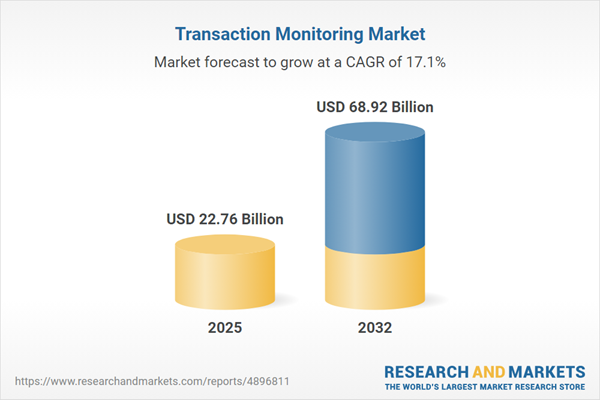Speak directly to the analyst to clarify any post sales queries you may have.
Transaction monitoring market solutions are reshaping how organizations approach financial risk, compliance, and operational efficiency amid mounting digital payment activity and evolving regulatory demands. Senior leaders are prioritizing adaptive platforms to protect assets, ensure transparency, and maintain compliance in the face of increasing complexity.
Market Snapshot: Transaction Monitoring Market Growth and Opportunity
The transaction monitoring market is projected for significant expansion through 2032, propelled by increasing digital payment volumes and heightened oversight from regulators across industries. As enterprises enhance their financial operations and expand in digital channels, compliance requirements are driving the adoption of proactive, future-ready strategies. Advanced anti-money laundering and fraud detection technologies are being embedded within existing compliance systems, bolstering operational resilience. Market providers differentiate themselves through versatile, scalable platforms that accommodate various regulatory frameworks. Decision-makers select partners based on adaptability and the ability to support global operations, highlighting robust transaction monitoring as indispensable for sustainable compliance and improved financial management.
Scope & Segmentation of the Transaction Monitoring Market
The transaction monitoring market’s scope encompasses a wide range of sectors and geographies, reflecting the diverse business goals and compliance needs of organizations. Key segmentation includes:
- Component: Managed services, real-time analytics, deployment support, and behavioral detection tools all enable expedient identification of suspicious digital transaction activity.
- Organization Size: Platforms scale to serve both global enterprises and regional or mid-sized firms, supporting compliance initiatives without excess complexity.
- Deployment Type: Organizations choose between cloud-based and on-premise deployments, aligning with their IT strategies, data residency requirements, and regulatory directives.
- Application: Transaction monitoring supports anti-money laundering, fraud prevention, Know Your Customer initiatives, risk management, and audit readiness within varied operational settings.
- Industry Vertical: Financial services, insurance, government, healthcare, telecommunications, IT, and retail sectors each apply specialized compliance measures to support data security and regulatory obligations.
- Geographic Regions: Adoption spans the Americas, EMEA, and Asia-Pacific. Markets such as the United States, Brazil, United Kingdom, Germany, Saudi Arabia, South Africa, China, India, and Australia face unique regulatory and operational challenges, making local expertise and global reach crucial.
- Leading Companies: Solutions from providers such as NICE Actimize, ComplyAdvantage, LexisNexis Risk Solutions, SAS Institute, Flagright, Feedzai, Alessa by CaseWare, Fenergo, Unit21, and Oracle Corporation cater to both global and region-specific compliance demands.
Key Takeaways: Strategic Insights for Transaction Monitoring Decision-Makers
- Modular, cloud-native transaction monitoring platforms enable organizations to swiftly adjust to new compliance requirements, balancing operational agility with cost-effectiveness when compared to traditional systems.
- Artificial intelligence and machine learning elevate the detection of noncompliant transactions, supporting quicker and more accurate investigations by processing large quantities of transactional data in real-time.
- Flexible compliance architectures empower businesses to operate seamlessly in dynamic regulatory environments, enabling consistent standards across multiple jurisdictions.
- Maintaining real-time oversight over transaction flows supports effective risk management, especially as cross-border payments and transaction complexity increase.
- Collaborating with managed service providers enables compliance teams to focus on higher-value strategic functions, while ensuring system responsiveness and adaptability at global and regional scales.
Tariff Impact: Navigating US Tariff Shifts on Monitoring Infrastructure
Continued shifts in US tariffs are prompting a reassessment of transaction monitoring strategies among financial organizations. Increased costs for hardware are accelerating shifts toward cloud-based solutions, valued for their scalability, resilience, and flexibility amid supply chain and policy changes. Subscription models help organizations align spending with the evolving pace of infrastructure needs, while engagement with local technology providers and adaptable payment structures help insulate operations from unpredictable tariff effects and ensure ongoing compliance as trade rules change.
Methodology & Data Sources
This analysis is based on interviews with senior compliance, risk, and technology executives, combined with sector benchmarks. Data validation against current regulatory frameworks ensures that actionable recommendations are relevant for executive-level decision-making.
Why This Report Matters
- Delivers clear, practical insights to enhance compliance systems and support digital transformation in response to regulatory change.
- Explains how artificial intelligence and machine learning can streamline financial crime prevention and risk management workflows.
- Guides technology strategy in line with evolving market and regulatory dynamics, empowering leaders to plan and execute effective compliance initiatives.
Conclusion
Implementing robust transaction monitoring empowers senior leaders to navigate complex regulatory demands and strengthen digital resilience. Strategic technology decisions support organizations in meeting compliance standards and securing operational success as industry needs evolve.
Additional Product Information:
- Purchase of this report includes 1 year online access with quarterly updates.
- This report can be updated on request. Please contact our Customer Experience team using the Ask a Question widget on our website.
Table of Contents
3. Executive Summary
4. Market Overview
7. Cumulative Impact of Artificial Intelligence 2025
Companies Mentioned
The companies profiled in this Transaction Monitoring market report include:- NICE Actimize, Inc.
- ComplyAdvantage Ltd.
- LexisNexis Risk Solutions
- SAS Institute Inc.
- Flagright Inc.
- Feedzai Inc.
- Alessa by CaseWare
- Fenergo Ltd.
- Unit21 Inc.
- Oracle Corporation
Table Information
| Report Attribute | Details |
|---|---|
| No. of Pages | 198 |
| Published | October 2025 |
| Forecast Period | 2025 - 2032 |
| Estimated Market Value ( USD | $ 22.76 Billion |
| Forecasted Market Value ( USD | $ 68.92 Billion |
| Compound Annual Growth Rate | 17.1% |
| Regions Covered | Global |
| No. of Companies Mentioned | 11 |









